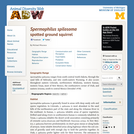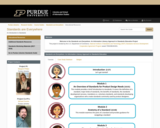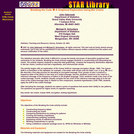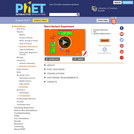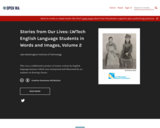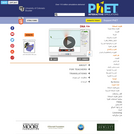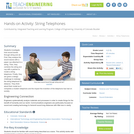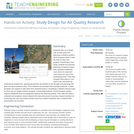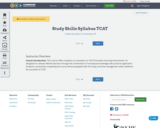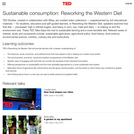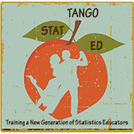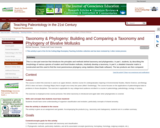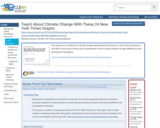Purpose & Overview: This 2-part exercise introduces students to the concepts and methods employed within the disciplines of taxonomy and phylogeny.
In part I, students work with a collection of approximately 25 species of extant and fossil bivalve mollusks (C-Bivalvia) without knowing in advance of their taxonomic group assignments. Based on the shell morphology they observe and the soft part morphology they acquire from a collection of figures, they are asked to build a classification scheme (i.e., place the bivalves in some hierarchical taxonomic structure). They are intentionally not given any guidance and are welcome to organize the species using any method they wish. Students accomplish this is groups. The hope or intent is that countless taxonomic schemes will be generated by the class and therefore recognize the subjectivity involved. (When their taxonomic schemes are later compared against the MacClade-derived cladograms they learn that the majority of their taxa are not monophyletic clades.)
Part II should not begin until after part I has been completed. For part II, the same bivalve species (specimens and figures) are used, but now the class is asked to collaborate to generate a large morphological character data matrix that will become the data set used with MacClade. Each student then working independently with MacClade on a Macintosh computer (a university computer laboratory is reserved for this meeting) creates a cladogram of their intuition-based taxonomic topology using the data matrix and the treelength is noted. Then, using MacClade's tools, each student attempts to find one or more most parsimonious cladograms. All most parsimonious cladograms are collected and compiled to generate a consensus tree. Ultimately each student is then asked to compare their intuition-based topology against the consensus, most parsimonious cladogram. In a written assignment, the discrepancies are explained.
Materials:
1. A collection of ~ 25 species of extant and fossil bivalves. The species used for the FGCU exercise are listed in an attached document. Virtually any collection would suffice. It's beneficial, however, to have a variety of subclasses and orders represented. Ideally and with students working in groups it's best to have a collection of 25 specimens for each group.
2. Figures illustrating the soft part morphology of the bivalve species. I've assembled a collection of figures taken from an identification book authored by "Mikkelsen & Bieler" (see full citation below). The figures I use are assembled as a PowerPoint presentation; this is either shared electronically with the students or color photocopies are brought to class. (See attached PowerPoint file.) Some species are not represented by figures in this text. In those situations, I've chosen the most closely related species within the book as a proxy.
3. A collection of Macintosh computers and MacClade software (v. 4.08 the most recent). FGCU has a site license so the software can be run on multiple machines simultaneously. The software is loaded within a computer laboratory.
Procedure:
For Part I:
1. The class is assembled into groups (3 or 4 persons per group is ideal) and each group is given a collection of bivalve species and the collection of figures. Each species is uniquely numbered; species names can be provided, but students must not research their taxonomic affiliations. Each group is asked to place the species within a hierarchical classification scheme. They must have some rationale for its organization. The classification scheme they develop should be graphically drafted as a nested hierarchy (as a tree). (30 mins)
2. Each group reports back to the class. (15 mins)
For Part II:
1. The goal for this step is to obtain one comprehensive matrix that the entire class will use for the cladistic analysis. The groups first reassemble (at a later date once part I is complete) to identify characters and character states. The entire class is reunited to collect the best characters, character states, and state codes for each species. This is facilitated as quickly as possible in a class-wide discussion. At home the students are required to generate a formal matrix (either by hand or using Excel) in the appropriate format for MacClade. (30 mins)
2. In a subsequent meeting, the students assemble in a computer lab to conduct the cladistic analysis using MacClade. If time permits, each student may enter the data matrix, or the instructor can upload the matrix in advance of the meeting.
3. Students should first manipulate a cladogram by hand representing the taxonomy developed in part I. A treelength should be obtained and the cladogram should be saved and printed.
4. Students are then tasked with finding the most parsimonious cladograms by using MacClade's branch swapping tools. One species is designated as the outgroup; and this is used to define character polarity. (In my collection of bivalves, Nucula is the outgroup.) Students work independently upon this. Once a new cladogram with a shorter treelength is discovered, the students are redirected to find equally or more parsimonious alternatives. After some finite length of time (typically a class period: 45 -- 60 mins for the entire computer lab meeting), the most parsimonious cladograms are collected and saved.
5. At a later meeting, the instructor generates a consensus cladogram of the most parsimonious and this tree plus each individual most parsimonious cladogram is distributed to the students. The students at this point may be tasked to analyze the results individually without any further guidance; they may be asked to do that analysis in small groups; or a class-wide facilitated discussion may accomplish the same thing. Once this is complete, students are given the writing assignment and a deadline is established.
The following files are uploaded as supportive teaching materials:
1. PowerPoint file with figures of bivalves taken from Mikkelsen & Bieler, 2007. Titled: SW FL Common Bivalve Morphologies.
2. Handout given to students describing part I. Word file titled: Exercise 5 Pt I Bivalve Taxonomy.
3. Handout given to students describing part II. Word file titled: Exercise 5 Pt II Bivalve Phylogeny.
4. Handout given to student with list of species names of bivalves within the collection. Word file titled: Common Southwest Florida Bivalve Mollusks.
5. Word file for instructors only with same list of bivalve species but within the established classification hierarchy. Titled: Common Southwest Florida Bivalve Mollusks with taxonomy.
6. Sample list of characters and character states defined by a recent class. Word file titled: Bivalve Characteristics and States.
7. Sample character matrix for the above bivalve species developed by a recent class. Excel file titled: Bivalve Character Matrix.
8. A file with instructor notes containing helpful hints, thoughts, and observations about the exercise's implementation. Word file titled: Instructor Notes Bivalve Phylogeny.
(Note: this resource was added to OER Commons as part of a batch upload of over 2,200 records. If you notice an issue with the quality of the metadata, please let us know by using the 'report' button and we will flag it for consideration.)

